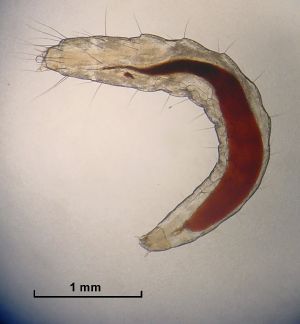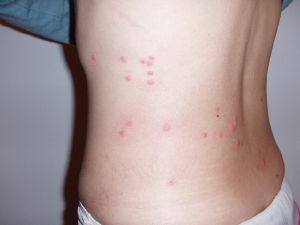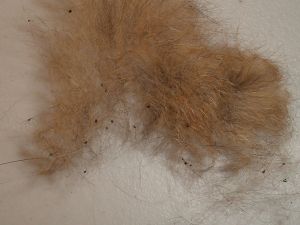Difference between revisions of "Flea" - New World Encyclopedia
Katya Swarts (talk | contribs) m |
Rick Swarts (talk | contribs) (added most recent Wikipedia version) |
||
| Line 1: | Line 1: | ||
| − | {{ | + | {{Taxobox |
| − | + | | color = pink | |
| − | + | | name = Fleas | |
| − | + | | image = Scanning_Electron_Micrograph_of_a_Flea.jpg | |
| − | + | | image_width = 200px | |
| − | + | | image_caption = [[Scanning electron microscope|SEM]] of a flea | |
| − | + | | domain = [[Eukaryote|Eukaryota]] | |
| − | + | | regnum = [[Animal]]ia | |
| − | + | | phylum = [[Arthropod]]a | |
| − | + | | classis = [[Insect]]a | |
| − | + | | subclassis = [[Pterygota]] | |
| − | + | | infraclassis = [[Neoptera]] | |
| − | + | | superordo = [[Endopterygota]] | |
| − | + | | ordo = '''Siphonaptera''' | |
| − | [[Tungidae]] | + | | subdivision_ranks = Families |
| − | [[Pulicidae]] | + | | subdivision = |
| + | [[Tungidae]] – sticktight and [[chigoe flea]]s (chiggers) <br> | ||
| + | [[Pulicidae]] – common fleas<br> | ||
[[Coptopsyllidae]]<br> | [[Coptopsyllidae]]<br> | ||
| − | [[Vermipsyllidae]] | + | [[Vermipsyllidae]] – carnivore fleas<br> |
| − | [[Rhopalopsyllidae]] | + | [[Rhopalopsyllidae]] – marsupial fleas<br> |
[[Hypsophthalmidae]]<br> | [[Hypsophthalmidae]]<br> | ||
[[Stephanocircidae]]<br> | [[Stephanocircidae]]<br> | ||
[[Pygiopsyllidae]]<br> | [[Pygiopsyllidae]]<br> | ||
| − | [[Hystrichopsyllidae]] | + | [[Hystrichopsyllidae]] – rat and mouse fleas<br> |
| − | [[Leptopsyllidae]] | + | [[Leptopsyllidae]] – mouse and rat fleas<br> |
| − | [[Ischnopsyllidae]] | + | [[Ischnopsyllidae]] – bat fleas<br> |
| − | [[Ceratophyllidae]] | + | [[Ceratophyllidae]]:-fleas mainly associated with rodents |
[[Amphipsyllidae]]<br> | [[Amphipsyllidae]]<br> | ||
[[Malacopsyllidae]]<br> | [[Malacopsyllidae]]<br> | ||
| − | [[Dolichopsyllidae]] | + | [[Dolichopsyllidae]] – rodent fleas<br> |
[[Ctenopsyllidae]] | [[Ctenopsyllidae]] | ||
| − | + | }} | |
'''Flea''' is the [[common name]] for any of the small wingless [[insect]]s of the [[order (biology)|order]] '''Siphonaptera''' (some authorities use the name '''Aphaniptera''' because it is older, but [[circumscriptional name|names above family rank]] do not follow the rules of priority, so most taxonomists use the more familiar name). Fleas are external [[parasite]]s, living by [[hematophagy]] off the [[blood]] of [[mammal]]s and [[bird]]s, and genetic and morphological evidence indicates that they are descendants of the [[Scorpionfly]] family [[Boreidae]], which are also flightless; accordingly it is possible that they will eventually be reclassified as a suborder within the [[Mecoptera]]. In the past, however, it was most commonly supposed that fleas had evolved from the [[fly|flies]] ([[Diptera]]), based on similarities of the larvae. | '''Flea''' is the [[common name]] for any of the small wingless [[insect]]s of the [[order (biology)|order]] '''Siphonaptera''' (some authorities use the name '''Aphaniptera''' because it is older, but [[circumscriptional name|names above family rank]] do not follow the rules of priority, so most taxonomists use the more familiar name). Fleas are external [[parasite]]s, living by [[hematophagy]] off the [[blood]] of [[mammal]]s and [[bird]]s, and genetic and morphological evidence indicates that they are descendants of the [[Scorpionfly]] family [[Boreidae]], which are also flightless; accordingly it is possible that they will eventually be reclassified as a suborder within the [[Mecoptera]]. In the past, however, it was most commonly supposed that fleas had evolved from the [[fly|flies]] ([[Diptera]]), based on similarities of the larvae. | ||
| − | ''Note'': There is also a genus of [[foraminifera]]n [[Protozoa]] named '' | + | ''Note'': There is also a genus of [[foraminifera]]n [[Protozoa]] named ''Siphonaptera'' |
Some well known flea species include: | Some well known flea species include: | ||
| Line 41: | Line 43: | ||
* [[Rat flea|Oriental rat flea]] (''Xenopsylla cheopis''). | * [[Rat flea|Oriental rat flea]] (''Xenopsylla cheopis''). | ||
| − | |||
| − | |||
| − | + | ==Morphology and behavior== | |
| − | |||
| − | == | ||
[[Image:HookeFlea01.jpg|thumb|left|[[Robert Hooke|Hooke's]] drawing of a flea in ''[[Micrographia]]'']] | [[Image:HookeFlea01.jpg|thumb|left|[[Robert Hooke|Hooke's]] drawing of a flea in ''[[Micrographia]]'']] | ||
| − | Fleas | + | Fleas are small (1/16 to 1/8-[[inch]] (1.5 to 3.3 mm) long), agile, usually dark coloured (e.g. the reddish-brown of the cat flea), wingless insects with tube-like mouthparts adapted to feeding on the blood of their hosts. Their bodies are laterally compressed, (i.e., flattened side to side) permitting easy movement through the hairs (or feathers etc.) on the host's body. Their legs are long, the hind pair well adapted for jumping (vertically up to seven inches (18 cm); horizontally thirteen inches (33 cm)<ref name=Ohio> [http://ohioline.osu.edu/hyg-fact/2000/2081.html Fleas, HYG-2081-97] William F. Lyon, [[Ohio State University]] entomology page. Accessed 28 December 2006</ref>) - around 200 times their own body length. The flea body is hard, polished, and covered with many hairs and short spines directed backward<ref name=Florida>[http://edis.ifas.ufl.edu/IG087 Fleas] - P.G. Koehler and F. M. Oi. Printed July 1993, revised February 2003. Provided by the [[University of Florida]]</ref>, allowing the flea a smooth passage through the hairs of its host. Its tough body is able to withstand great pressure, likely an adaptation to survive scratching etc. Even hard squeezing between the fingers is often insufficient to kill the flea; it may be necessary to crush them between the fingernails. |
| − | |||
| − | |||
| − | + | Fleas lay tiny white oval shaped eggs. Their larvae are small and pale with bristles covering their worm-like body. They are without eyes, and have mouthparts adapted to chewing. While the adult flea's diet consists solely of blood, their larvae feed on various organic matter including the feces of mature fleas.<ref name=BugGuide>[http://bugguide.net/node/view/7040 Order Siphonaptera - Fleas - BugGuide.Net] Accessed 28 December 2006</ref> In the pupae phase the larvae are enclosed in a silken, debris covered cocoon. | |
| − | + | ==Life cycle and habitat== | |
| + | Fleas are [[holometabolism|holometabolous]] insects, going through the four [[Biological life cycle|life cycle]] stages of [[embryo]], [[larva]], [[pupa]] and [[imago]] (adult). The flea life cycle begins when the female lays after feeding. Adult fleas must feed on blood before they can become capable of reproduction.<ref name="Florida" /> Eggs are laid in batches of up to 20 or so, usually on the host itself, which easily roll onto the ground. As such, areas where the host rests and sleeps become one of the primary [[habitat]]s of eggs and developing fleas. The eggs take around two days to two weeks to hatch<ref name="Ohio" />. | ||
| − | + | [[Image:Flea Larva.jpg|right|thumb|[[Micrograph]] of a flea larva.]] | |
| − | [[Image:Flea Larva.jpg|thumb| | + | Flea larvae emerge from the eggs to feed on any available organic material such as dead insects, feces and vegetable matter. They are blind and avoid sunlight, keeping to dark places like sand, cracks and crevices, and bedding. Given an adequate supply of food larvae should pupate within 1-2 weeks. After going through three larval stages they spin a [[silk]]en cocoon. After another week or two the adult flea is fully developed and ready to emerge from the cocoon. They may however remain resting during this period until they receive a signal that a host is near - vibrations (including sound), heat and [[carbon dioxide]] are all stimuli indicating the probable presence of a host.<ref name="Ohio" /> Fleas are known to [[overwinter]] in the larval or pupal stages. |
| − | |||
| − | + | Once the flea reaches adulthood its primary goal is to find blood. Adult fleas only have around a week to find food once they emerge, though they can survive two months to a year between meals. A flea population is unevenly distributed, with 50 percent eggs, 35 percent larvae, 10 percent pupae and 5 percent adults.<ref name="Ohio" /> Their total life cycle can take as little as two weeks, but may be lengthened to many months if conditions are favourable. Female fleas can lay 500 or more eggs over their life, allowing for phenomenal growth rates. | |
| − | |||
| − | + | ==Evolution and classification== | |
| − | + | Fleas are apparently related to [[scorpionfly|scorpionflies]]<ref name=Grimaldi>[[David Grimaldi|Grimaldi, D.]] and [[Michael S. Engel|Engel, M.S.]] ([[2005]]). ''Evolution of the Insects''. [[Cambridge University Press]]. ISBN 0-521-82149-5.</ref>, winged insects with good eyesight. The flightless [[snow flea]] with its [[vestigial structure|rudimentary]] wings seems to be close to the common ancestor of the 2000 or so currently known varieties of flea, which split off in many directions around 160 million years ago.<ref name="Grimaldi" /> Their evolution continued to produce adaptations for their specialized parasitic niche, such that they now have no wings and their eyes are covered over. The large number of flea species may be attributed to the wide variety of host species they feed on, which provides so many specific [[ecological niche]]s to adapt to. | |
| − | == | + | ==Relationship with host== |
| − | + | [[Image:Fleabite.JPG|thumb|left|Flea bites on the back of a human]] | |
| + | Fleas attack a wide variety of [[warm-blooded]] [[vertebrate]]s including dogs, humans, chickens, rabbits, squirrels, rats and mice. Fleas are a nuisance to their hosts, causing an [[itch]]ing sensation which in turn may result in the host attempting to remove the pest by biting, pecking, scratching etc the vicinity of the parasite. Fleas are not simply a source of annoyance, however. Some people and animals suffer [[allergic reaction]]s to flea [[saliva]] resulting in [[rash]]es. Flea bites generally result in the formation of a slightly-raised swollen itching spot with a single puncture point at the center. The bites often appear in clusters or lines, and can remain itchy and inflamed for up to several weeks afterwards. Fleas can also lead to hair loss as a result of frequent scratching and biting by the animal, and can cause [[anemia]] in extreme cases. | ||
| − | + | Besides the problems posed by the creature itself, fleas can also act as a [[vector (biology)|vector]] for [[disease]]. For example, fleas transmitted the [[bubonic plague]] between rodents and humans by carrying ''[[Yersinia pestis]]'' bacteria. Murine typhus (endemic typhus) fever, and in some cases [[tapeworm]]s, ''[[Hymenolepis]]'', can also be transmitted by fleas. | |
| − | |||
| − | |||
| − | |||
| − | |||
| − | == | + | == Flea treatments == |
| − | + | [[Image:Fleadirt.jpg|thumb|right|Flea "dirt" in the fur of a cat, is actually excess blood (from host) consumed by the adult flea, passed as feces.]] | |
| − | + | Flea [[bite]]s can be treated with [[Calamine lotion]] or 0.5-1% conc. [[hydrocortisone]] cream. [[Lufenuron]] is a veterinary medicine that attacks the larval flea's ability to produce [[chitin]]. See also [[Frontline (medicine)]]. | |
| − | |||
| − | |||
| − | |||
| − | |||
| − | |||
| − | |||
| − | + | Flea medicines need to be used with care. [[Phenothrin]] (85.7%) in combination with [[Methoprene]] was a popular topical flea/tick therapy for felines. Phenothrin kills adult fleas and ticks. Methoprene is an insect growth regulator that interrupts the insect's life cycle by killing the eggs. However, the US [[EPA]] has pressured at least one manufacturer of products containing these compounds to voluntarily withdraw some products and include strong cautionary statements on others, warning of adverse feline toxicity. The Phenothrin was believed to be the cause of the adverse reactions <ref>[http://www.epa.gov/pesticides/factsheets/flea-tick-drops.htm EPA: Pesticides - Hartz Flea and Tick Drops for Cats and Kittens to be Phased Out]</ref> | |
| − | [[ | + | A combination of etofenprox (55.0%) and [[pyriproxyfen]] (2.2%) is another formulation used in Sergeant's Gold treatment for cats, and possibly others. |
| − | + | Fleas can be controlled in dwellings by application of [[borax]], [[diatomaceous earth]], and other [[insecticides]] to floors, furniture and carpeting. | |
| − | + | == References == | |
| + | <references/> | ||
== External links == | == External links == | ||
| + | {{commonscat|Siphonaptera}} | ||
| + | * {{dmoz|Science/Biology/Flora_and_Fauna/Animalia/Arthropoda/Insecta/Fleas/}} | ||
* [http://parents.berkeley.edu/advice/health/fleas.html Advice about fleas] from the Berkeley Parents Network | * [http://parents.berkeley.edu/advice/health/fleas.html Advice about fleas] from the Berkeley Parents Network | ||
* [http://www.lib.uiowa.edu/hardin/md/fleabites.html Links to flea bite pictures (Hardin MD/Univ of Iowa)] | * [http://www.lib.uiowa.edu/hardin/md/fleabites.html Links to flea bite pictures (Hardin MD/Univ of Iowa)] | ||
* [http://www.primalnature.org/wildlife.html Good Neighbors] An essay on the natural history of the flea | * [http://www.primalnature.org/wildlife.html Good Neighbors] An essay on the natural history of the flea | ||
| − | |||
*[http://www.petloveshack.com/flea.html Breaking the Flea Cycle] | *[http://www.petloveshack.com/flea.html Breaking the Flea Cycle] | ||
| + | *[http://pests.in/fleas.html How to get rid of fleas] | ||
*[http://eastvillagepodcasts.com/2006/06/13/my-foot-and-sand-flea-bites/ Sand Flea Bite Picture] | *[http://eastvillagepodcasts.com/2006/06/13/my-foot-and-sand-flea-bites/ Sand Flea Bite Picture] | ||
| + | *[http://www.wood.army.mil/chmdsd/Army_Chemical_Review/pdfs/Jul-Dec%202005/Kirby.pdf Flea As Weapon] | ||
| + | |||
| − | {{credit| | + | {{credit|113534721}} |
Revision as of 15:35, 11 March 2007
| Fleas | ||||||||||||||||
|---|---|---|---|---|---|---|---|---|---|---|---|---|---|---|---|---|
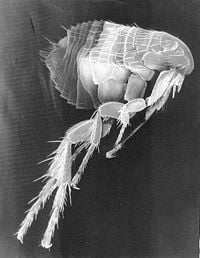 SEM of a flea
| ||||||||||||||||
| Scientific classification | ||||||||||||||||
| ||||||||||||||||
|
Tungidae – sticktight and chigoe fleas (chiggers) |
Flea is the common name for any of the small wingless insects of the order Siphonaptera (some authorities use the name Aphaniptera because it is older, but names above family rank do not follow the rules of priority, so most taxonomists use the more familiar name). Fleas are external parasites, living by hematophagy off the blood of mammals and birds, and genetic and morphological evidence indicates that they are descendants of the Scorpionfly family Boreidae, which are also flightless; accordingly it is possible that they will eventually be reclassified as a suborder within the Mecoptera. In the past, however, it was most commonly supposed that fleas had evolved from the flies (Diptera), based on similarities of the larvae.
Note: There is also a genus of foraminiferan Protozoa named Siphonaptera
Some well known flea species include:
- Cat flea (Ctenocephalides felis),
- Dog flea (Ctenocephalides canis),
- Human flea (Pulex irritans),
- Northern rat flea (Nosopsyllus fasciatus),
- Oriental rat flea (Xenopsylla cheopis).
Morphology and behavior
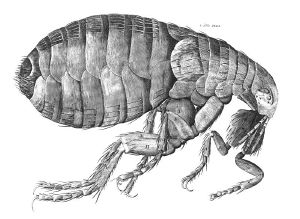
Fleas are small (1/16 to 1/8-inch (1.5 to 3.3 mm) long), agile, usually dark coloured (e.g. the reddish-brown of the cat flea), wingless insects with tube-like mouthparts adapted to feeding on the blood of their hosts. Their bodies are laterally compressed, (i.e., flattened side to side) permitting easy movement through the hairs (or feathers etc.) on the host's body. Their legs are long, the hind pair well adapted for jumping (vertically up to seven inches (18 cm); horizontally thirteen inches (33 cm)[1]) - around 200 times their own body length. The flea body is hard, polished, and covered with many hairs and short spines directed backward[2], allowing the flea a smooth passage through the hairs of its host. Its tough body is able to withstand great pressure, likely an adaptation to survive scratching etc. Even hard squeezing between the fingers is often insufficient to kill the flea; it may be necessary to crush them between the fingernails.
Fleas lay tiny white oval shaped eggs. Their larvae are small and pale with bristles covering their worm-like body. They are without eyes, and have mouthparts adapted to chewing. While the adult flea's diet consists solely of blood, their larvae feed on various organic matter including the feces of mature fleas.[3] In the pupae phase the larvae are enclosed in a silken, debris covered cocoon.
Life cycle and habitat
Fleas are holometabolous insects, going through the four life cycle stages of embryo, larva, pupa and imago (adult). The flea life cycle begins when the female lays after feeding. Adult fleas must feed on blood before they can become capable of reproduction.[2] Eggs are laid in batches of up to 20 or so, usually on the host itself, which easily roll onto the ground. As such, areas where the host rests and sleeps become one of the primary habitats of eggs and developing fleas. The eggs take around two days to two weeks to hatch[1].
Flea larvae emerge from the eggs to feed on any available organic material such as dead insects, feces and vegetable matter. They are blind and avoid sunlight, keeping to dark places like sand, cracks and crevices, and bedding. Given an adequate supply of food larvae should pupate within 1-2 weeks. After going through three larval stages they spin a silken cocoon. After another week or two the adult flea is fully developed and ready to emerge from the cocoon. They may however remain resting during this period until they receive a signal that a host is near - vibrations (including sound), heat and carbon dioxide are all stimuli indicating the probable presence of a host.[1] Fleas are known to overwinter in the larval or pupal stages.
Once the flea reaches adulthood its primary goal is to find blood. Adult fleas only have around a week to find food once they emerge, though they can survive two months to a year between meals. A flea population is unevenly distributed, with 50 percent eggs, 35 percent larvae, 10 percent pupae and 5 percent adults.[1] Their total life cycle can take as little as two weeks, but may be lengthened to many months if conditions are favourable. Female fleas can lay 500 or more eggs over their life, allowing for phenomenal growth rates.
Evolution and classification
Fleas are apparently related to scorpionflies[4], winged insects with good eyesight. The flightless snow flea with its rudimentary wings seems to be close to the common ancestor of the 2000 or so currently known varieties of flea, which split off in many directions around 160 million years ago.[4] Their evolution continued to produce adaptations for their specialized parasitic niche, such that they now have no wings and their eyes are covered over. The large number of flea species may be attributed to the wide variety of host species they feed on, which provides so many specific ecological niches to adapt to.
Relationship with host
Fleas attack a wide variety of warm-blooded vertebrates including dogs, humans, chickens, rabbits, squirrels, rats and mice. Fleas are a nuisance to their hosts, causing an itching sensation which in turn may result in the host attempting to remove the pest by biting, pecking, scratching etc the vicinity of the parasite. Fleas are not simply a source of annoyance, however. Some people and animals suffer allergic reactions to flea saliva resulting in rashes. Flea bites generally result in the formation of a slightly-raised swollen itching spot with a single puncture point at the center. The bites often appear in clusters or lines, and can remain itchy and inflamed for up to several weeks afterwards. Fleas can also lead to hair loss as a result of frequent scratching and biting by the animal, and can cause anemia in extreme cases.
Besides the problems posed by the creature itself, fleas can also act as a vector for disease. For example, fleas transmitted the bubonic plague between rodents and humans by carrying Yersinia pestis bacteria. Murine typhus (endemic typhus) fever, and in some cases tapeworms, Hymenolepis, can also be transmitted by fleas.
Flea treatments
Flea bites can be treated with Calamine lotion or 0.5-1% conc. hydrocortisone cream. Lufenuron is a veterinary medicine that attacks the larval flea's ability to produce chitin. See also Frontline (medicine).
Flea medicines need to be used with care. Phenothrin (85.7%) in combination with Methoprene was a popular topical flea/tick therapy for felines. Phenothrin kills adult fleas and ticks. Methoprene is an insect growth regulator that interrupts the insect's life cycle by killing the eggs. However, the US EPA has pressured at least one manufacturer of products containing these compounds to voluntarily withdraw some products and include strong cautionary statements on others, warning of adverse feline toxicity. The Phenothrin was believed to be the cause of the adverse reactions [5]
A combination of etofenprox (55.0%) and pyriproxyfen (2.2%) is another formulation used in Sergeant's Gold treatment for cats, and possibly others.
Fleas can be controlled in dwellings by application of borax, diatomaceous earth, and other insecticides to floors, furniture and carpeting.
ReferencesISBN links support NWE through referral fees
- ↑ 1.0 1.1 1.2 1.3 Fleas, HYG-2081-97 William F. Lyon, Ohio State University entomology page. Accessed 28 December 2006
- ↑ 2.0 2.1 Fleas - P.G. Koehler and F. M. Oi. Printed July 1993, revised February 2003. Provided by the University of Florida
- ↑ Order Siphonaptera - Fleas - BugGuide.Net Accessed 28 December 2006
- ↑ 4.0 4.1 Grimaldi, D. and Engel, M.S. (2005). Evolution of the Insects. Cambridge University Press. ISBN 0-521-82149-5.
- ↑ EPA: Pesticides - Hartz Flea and Tick Drops for Cats and Kittens to be Phased Out
External links
- {{{2}}} at the Open Directory Project
- Advice about fleas from the Berkeley Parents Network
- Links to flea bite pictures (Hardin MD/Univ of Iowa)
- Good Neighbors An essay on the natural history of the flea
- Breaking the Flea Cycle
- How to get rid of fleas
- Sand Flea Bite Picture
- Flea As Weapon
Credits
New World Encyclopedia writers and editors rewrote and completed the Wikipedia article in accordance with New World Encyclopedia standards. This article abides by terms of the Creative Commons CC-by-sa 3.0 License (CC-by-sa), which may be used and disseminated with proper attribution. Credit is due under the terms of this license that can reference both the New World Encyclopedia contributors and the selfless volunteer contributors of the Wikimedia Foundation. To cite this article click here for a list of acceptable citing formats.The history of earlier contributions by wikipedians is accessible to researchers here:
The history of this article since it was imported to New World Encyclopedia:
Note: Some restrictions may apply to use of individual images which are separately licensed.
